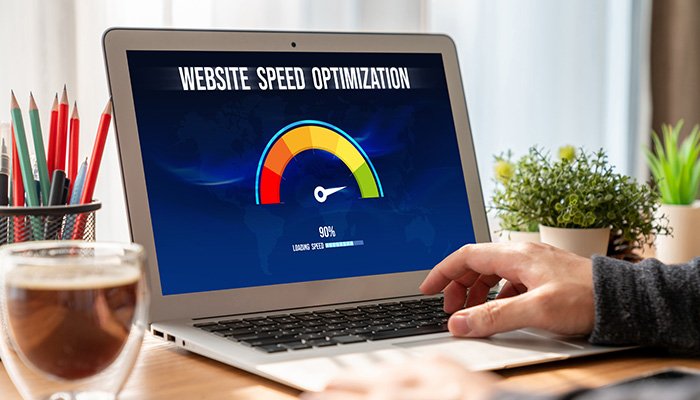
How to Optimize Your Website for Conversions: A Beginner’s Guide
July 25, 2025
AI for Branding: How Artificial Intelligence Shapes Modern Brand Identities
August 1, 2025Why Website Speed Matters More Than Ever in 2025
In a world where 53% of users abandon a site that takes more than 3 seconds to load (Google), your WordPress website speed can literally make or break your business. Not only does a slow site frustrate visitors, but it also negatively impacts SEO rankings, conversion rates and user experience.
According to Google’s Core Web Vitals, page speed is now a ranking factor. And with users primarily browsing from mobile devices, a sluggish site can lead to a sharp drop in traffic and engagement, especially for creatives, marketers and small business owners trying to showcase portfolios, services or ecommerce products.
The good news? You don’t need a developer to speed things up. With a few tested tools and optimizations, even non-tech users can dramatically improve website performance.
Step 1: Test Your Website Speed (Don’t Skip This!)
Before making changes, use these free tools to measure your current load time:
Google PageSpeed Insights – Provides desktop and mobile speed scores + actionable fixes
GTmetrix – Offers a waterfall analysis and performance recommendations
Pingdom Tools – Helps test from different locations globally
Aim for a load time under 2 seconds and a performance grade above 85%.

Step 2: Choose a Lightweight WordPress Theme
Your theme impacts how your site is rendered. Avoid bloated multipurpose themes and instead go for:
- GeneratePress: Extremely lightweight and optimized
- Astra: Great for creatives and portfolio sites
- Neve: Compatible with all major page builders
All three are mobile-responsive, SEO-friendly and recommended by WPBeginner, ThemeIsle and Kinsta
Step 3: Install a Caching Plugin (No Code Needed)
Caching stores static versions of your pages, reducing load times for repeat visitors.
Top WordPress caching plugins:
- WP Rocket (Paid) – Easiest to use and requires minimal configuration
- LiteSpeed Cache (Free) – Great for websites hosted on LiteSpeed servers
- W3 Total Cache (Free) – Very customizable but more complex
Tip: Only use one caching plugin at a time to avoid conflicts.
Step 4: Optimize Images for Web Without Losing Quality
Large image files are one of the biggest culprits of slow websites.
Recommended tools:
- Smush: Compresses images on upload (free & beginner-friendly)
- ShortPixel: Bulk optimization with WebP support
- TinyPNG: Online tool to compress PNG/JPG manually
WebP format is preferred in 2025 as it offers 25–35% smaller file sizes without compromising quality (Google Developers).

Step 5: Use a CDN (Content Delivery Network)
A CDN delivers your content from the nearest server to your visitor, reducing latency.
Top options:
- Cloudflare: Free tier available; also adds security and SSL
- net: Fast and affordable for global delivery
- StackPath – Great for U.S.-based traffic
According to GTmetrix, a CDN can reduce global page load times by up to 50%.
Step 6: Deactivate Unnecessary Plugins
Too many plugins slow down your site. Deactivate and delete:
Outdated plugins
- Plugins with overlapping functions (e.g., multiple SEO tools)
- Anything you’re not actively using
Then replace slow plugins with lighter alternatives. For example:
Replace Elementor with GenerateBlocks or Spectra for simpler sites
Switch Contact Form 7 to WPForms Lite
Step 7: Clean Your WordPress Database
Over time, your database gets bloated with post revisions, spam comments and transients.
Tools to clean it:
- WP-Optimize: Cleans database, compresses images and caches
- Advanced Database Cleaner: More granular control
Always back up your site before making database changes.
Step 8: Keep Everything Updated
Outdated themes, plugins or WordPress versions not only slow down your site but also pose security risks.
Always:
- Update WordPress core
- Update plugins/themes weekly
- Use managed hosting with automatic updates (e.g., SiteGround, Cloudways)
Bonus Tips
Lazy Load Images: Load images only when they scroll into view (built into WordPress 5.5+)
Minify CSS & JS: Tools like Autoptimize and WP Rocket do this automatically
Use Google Fonts Locally: Load fonts from your own server for better performance
Final Thoughts: Speed Is the New Design
Your website could have the best visuals, but if it loads slowly, visitors will bounce. Whether you’re running a design portfolio, agency website or online store, speed = trust + conversions.
Best of all? With just a few plugins and basic settings, you can boost your speed dramatically without writing a single line of code.
If you have any questions regarding “Speed Up a Slow WordPress Website” feel free to contact us. For inquiries and consultations, call us at: +92 321 4808303 or Email us at: hello@owaisgilani.com.
Disclaimer: The information shared on this website is for educational and informational purposes only and reflects my personal views and experiences. While I strive to provide accurate and helpful content, readers should use their own judgment and consult with a qualified professional before making any decisions based on the information here. I am not responsible for any actions taken based on this content. Feel free to reach out to me if you need clarification or have questions before using any part of this information.



